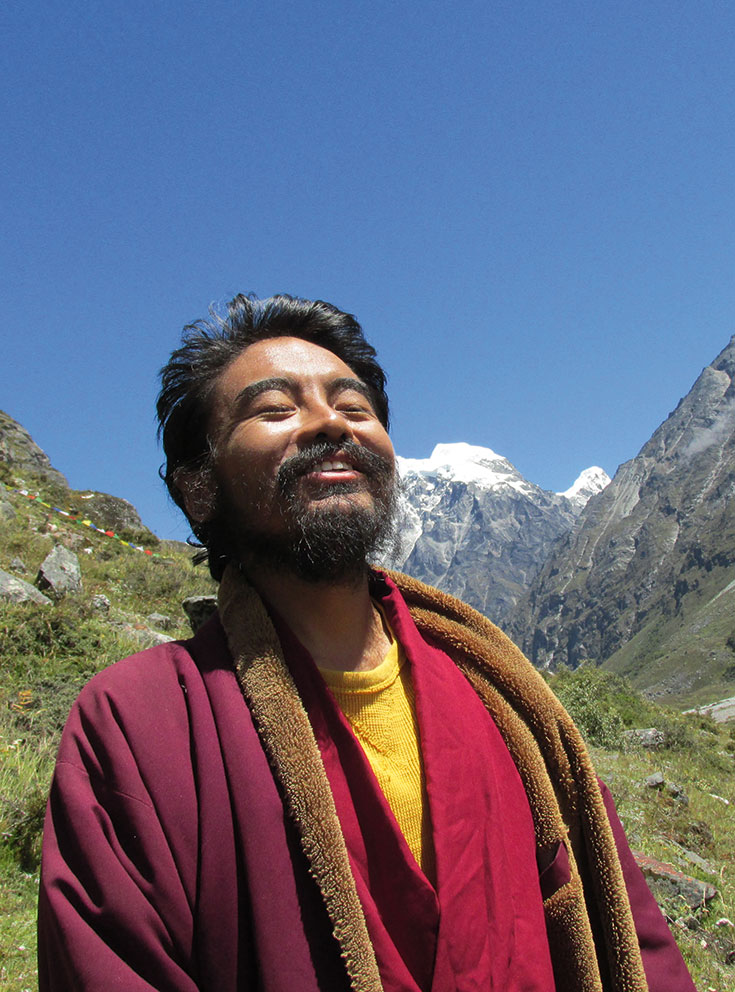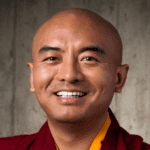I suffered terrible anxiety in my childhood. I desperately wanted to run away from it or fight it off. I don’t know exactly what the true cause of my panic was, but it manifested in many ways.
I was terrified of snowstorms. In my hometown in the Himalayas, winter brings many snowstorms. I remember one in particular. The wind was so intense it shook the house, and my mother found me holding fast to the house’s central beam. “What are you doing?” she asked. I said, “I have to save us from this wind!” Mom found this very funny.
I found no relief in the summer, either, with its rainstorms full of thunder and lightning. Sometimes, too, we would go down to Kathmandu Valley, and I was really scared of the public transportation there. We would ride the bus, and with each bump my heart would be bumping too. The sound of fireworks going off was a nightmare for me.
I tried so many ways to deal with my anxiety: running, playing, escaping into the nearby caves to hide. But nothing worked. In fact, I learned that aversion only makes anxiety bigger, stronger, and more solid.
Knowing how I struggled, my father, a famed meditation teacher, advised me to welcome my panic. So I dutifully began to greet each panic episode with, “Oh, hello, anxiety, welcome!” It did help somewhat, but because my motivation hadn’t actually changed, I was not handling it much differently. My basic attitude was still aversion. Now I was just trying to outsmart the fear, thinking that if I welcomed the panic it would go away and not come back. You could almost say I was faking it. Even this fake welcoming helped somewhat, but it didn’t resolve the issue. I was still going in circles—experiencing anxiety and being anxious to be rid of it, which would in turn reinforce it.
At thirteen, I started a three-year retreat at Sherab Ling Monastery, which was the main seat of one of my most important teachers, Tai Situ Rinpoche. I was hoping that in this structured environment, I could escape my laziness, but after a good start, it began to creep back in. Eventually, even in the structured meditations, my mind was all over the place. Then my panic returned, and got even worse—my laziness and my panic got together and became good friends!
The worse I felt about this, the stronger the panic got. Daily we met together in the great hall, sometimes doing traditional ritual practices with drums and the long, loud horns called dungchens. My throat would tighten, I couldn’t breathe, I’d get dizzy. I would have to leave in the middle of the prayers. And I had two more years to go!
“What should I do?” I asked myself. “Spend another two miserable years like this? Or should I truly welcome my panic?” I decided to really let go of wanting to block, get rid of, or fight it. I would finally learn how to live with it, and to use it as support for my meditation and awareness. I welcomed it for real.
What began to happen was that the panic was suspended in awareness. On the surface level was panic, but beneath it was awareness, holding it. This is because the vital first step to breaking the cycle of the anxious mind is to connect to awareness.
In meditation, we have different ways to achieve this. One of the most basic and essential steps is to bring our awareness to the breath. Just gently rest our attention on the inhale and exhale, without trying to change it in any way. And here are three other meditations you can do to work with feelings of anxiety, fear, or panic.

Meditate on Sound
Begin by sitting in a comfortable posture, letting the body be relaxed and at ease. Take a few moments to let awareness settle in the body, just noticing any sensations that are present.
Next, be aware of any sounds that are present. These might be pleasant, like birds singing outside; something we ordinarily think of as “noise,” like a neighbor’s dog barking; or sounds we find neutral. But whatever sounds you hear, just be with them. Notice how sounds arise, remain for a moment, and then disappear. There is no need to try to hang on to any specific sounds or disregard others. Simply embrace the sounds with a gentle touch of awareness.
When images, thoughts, or emotions occur in the mind, there is no need to block them; instead, allow them to accompany the sound, noticing how they can be present in awareness along with the sounds.
There is no need to focus strongly on a particular sound, but simply know that you are hearing—the knowing is meditation. Notice how awareness can accommodate any sound, without your having to do anything.
It is normal for your mind to wander off. Whenever you get lost, simply come back to being aware of the sounds in your surroundings.
Before ending the practice, take a moment to appreciate that you are capable of hearing. Appreciate that you have awareness, and that you are taking time to familiarize yourself with this ever-present awareness.
Change the Channel
Ordinarily, the anxious mind focuses on the negative and magnifies it. We can “change the channel” by doing the opposite. We can bring our awareness to the positive instead, perhaps by having gratitude and appreciation for the various types of good fortune we enjoy.
Traditionally in Buddhism, we rejoice in having been born into a human body, in having the five senses, in being born in that place of freedom. And of course, everybody has awareness, love, compassion, and wisdom. These are some simple things about being alive that we might appreciate.
Something else we should understand is that an anxious mind is always talking. Blah blah blah! Yadda yadda yadda! Yet, it is not the essential self that is anxious—it is merely the mind, having a lot of opinions. You are not your thoughts. This is a very important perspective to remember.
Break Your Anxiety into Pieces
We can bring awareness to any tactile sensations we’re experiencing in the body that are associated with anxiety. Once we tune in to the many sensations we are experiencing, we realize that anxiety has many facets or pieces.
Without trying to change anything, observe all those pieces of your experience. In doing so, you will find that you have physical sensations—for instance, the pulse racing, or a feeling of constriction. There will be an audio component, if nothing else the sound of your own breath. There will be visual images inside the mind.
And there will be beliefs, or what is traditionally called view. “Oh, this is right, this is wrong, this is dangerous.” Especially nowadays, in a world with so many competing views and forces bombarding us with projections and labels, we have all internalized specific views.
Now notice that what you were thinking of as one thing—anxiety—is actually made of four pieces. This multiplicity of pieces is always changing—there is nothing permanent there. At the same time, they’re all dependent on one another to create this experience of panic: without sensation, images, sound, and beliefs, there’s no anxiety. All of these parts are interdependent, impermanent, and changing, going up and down, up and down.
Once you break it down this way, panic loses its power. When you look at the deeper level of each piece and see there is nothing solid there, nothing permanent, the anxious mind loses power over you. At that moment, there’s openness.
Awareness is there, yet there is no grasping. Rest with that.
When we are out in the world living our lives, we should practice appreciation consistently. Be aware of all the gifts you have.
No matter what our circumstances, there is always much to be grateful for. If you begin to feel fear, remember it is merely thought, just a bunch of opinions. And if a powerfully anxious mind arises, recall that in reality there are many different pieces of this experience, and that they are all changing, all interdependent. There is nothing singular, solid, or permanent about anxiety. Let the mind rest in this awareness.
Please note that clinical anxiety is a medical condition. This article is not intended to provide or replace treatment options for those who may suffer from anxiety or other forms of mental illness.
If you are in need of help, you can call the National Suicide Prevention Lifeline at 1-800-273-TALK (8255) to access free, 24/7 confidential service for people in suicidal crisis or emotional distress, or those around them. The Lifeline provides support, information, and local resources. You can also text the Crisis Text Line at 741-741 for free 24/7 support with a trained crisis counselor right away.

